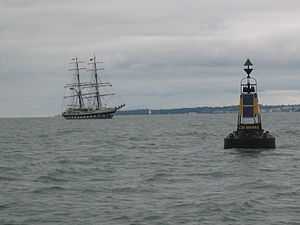Cardinal mark

A cardinal mark is a sea mark (a buoy or other floating or fixed structure) used in maritime pilotage to indicate the position of a hazard and the direction of safe water.
Cardinal marks indicate the direction of safety as a cardinal (compass) direction (north, east, south or west) relative to the mark. This makes them meaningful regardless of the direction or position of the approaching vessel, in contrast to the (perhaps better-known) lateral mark system.
The characteristics and meanings of cardinal marks are as defined by the International Association of Lighthouse Authorities.
A cardinal mark indicates one of the four compass directions by:
- the direction of its two conical top-marks, which can both point up, indicating north; down, indicating south; towards each other, indicating west; or away from each other, indicating east
- its distinctive pattern of black and yellow stripes, which follows the orientation of the cones - the black stripe is in the position pointed to by the cones (e.g. at the top for a north cardinal, in the middle for a west cardinal)
- optionally, its distinctive sequence of flashing light, which consists of a sequence of quick or very quick flashes whose number gives the clockface position which corresponds to the direction of the cardinal (e.g. three for an east cardinal, nine for a west; north has continuous flashes, and south may be augmented with a long flash, to help distinguish it from a west in difficult conditions)
The topmark configurations for north and south are self-explanatory (both cones pointing up, or both pointing down). Those for east and west "follow the Sun"—the top cone points in the direction in which the rising (for an east mark) or setting (for a west mark) Sun appears to move with respect to the horizon, while the bottom cone points in the direction in which its reflection on the ocean surface appears to move.
In the diagram, the light sequence is indicated by the white-banded pattern and the notation Q (for quick) or VQ (very quick). Either the quick or the very quick sequence may be used; the choice allows for two similar nearby marks to be uniquely identified by their lights.
A cardinal mark may be used to accomplish the following:
- Indicate that the deepest water is an area on the named side of the mark
- Indicate the safe side on which to pass a danger
- Draw attention to a feature in a channel, such as a bend, junction, branch, or end of a shoal
- Draw attention to a new danger such as a grounded ship. In such cases two equal marks are often placed together to indicate that it's a newly marked danger and is not yet printed in official charts.
Other uses:
- Sometimes a Cardinal Mark can be used instead of a Special mark to indicate a spoil ground, or an outfall pipe for example. A few examples can be seen on the South Coast of England and in Northern France.
-
Knoll North Cardinal
-

The 'East Bramble' East Cardinal Mark helps the Stavros S Niarchos navigate safely in the Solent, August 2008
-

All four types of cardinal mark used to warn of an old concrete base.
-
_in_ice_in_front_of_South_Harbor_Helsinki_Finland.jpg)
A light buoying cardinal mark in pressure of ice in front of Helsinki, Finland in winter. Notice that topmark is not used on a buoy that is subjected to ripping by movements of ice.
See also
References
| Wikimedia Commons has media related to Cardinal marks. |
- "Cardinal Marks". IALA.
